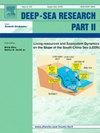热带印度洋海洋热浪事件的进程及其潜在机制
IF 3
3区 地球科学
Q2 OCEANOGRAPHY
Deep-sea Research Part Ii-topical Studies in Oceanography
Pub Date : 2025-02-01
DOI:10.1016/j.dsr2.2024.105438
引用次数: 0
摘要
海洋热浪(MHW)是毁灭性的极端海洋事件,对海洋和沿海生态系统具有严重和破坏性的影响。本文研究了近40年来热带印度洋(IO)强震事件的产生和发展及其主要调节因子。在过去十年中,在热带IO上发现了多次MHW事件。研究发现,2011年至2021年,热带印度洋的年平均强热带气旋日数和强热带气旋发生频率均显著增加。这与同一时期该地区海表温度(SST)的大幅上升相吻合。2015年在索马里海岸,2016年在爪哇-苏门答腊海岸,以及2019年和2020年在塞舌尔巨蛋发现了长期事件。事件具体分析显示,在2015年MHW事件第二阶段,沿索马里海岸观测到风速下降,导致上升流下沉,爪哇-苏门答腊海岸周围也有类似的观测结果。随后,分析了行星波在维持长时间磁暴事件中的作用。2015年和2016年,索马里和苏门答腊附近的海平面异常值为正,这表明存在下行行星波。这些行星波通过加深温跃层,从而抑制上升流和夹带作用,在海洋表面和次表面增温和混合中起重要作用。对2015年、2016年、2019年和2020年MHW事件活跃区域的混合层热收支项的分析表明,影响这些MHW事件的主要因素是大多数受影响地区的净热通量,其次是索马里地区的垂直平流的主导作用。本文章由计算机程序翻译,如有差异,请以英文原文为准。
Progression of marine heat wave events over the tropical Indian Ocean and its underlying mechanisms
Marine Heat Waves (MHW) are devastating extreme oceanic events that have severe and destructive effects on the marine and coastal ecosystems. In the present study, the generation and advancement of MHW events during the last four decades over the tropical Indian Ocean (IO) and its primary regulating factors are investigated. Multiple MHW events have been detected over the tropical IO in the past decade. It was found that between 2011 and 2021, the tropical Indian Ocean observed a significant increase in both the mean annual number of MHW days and the frequency of MHW occurrences. This coincided with a substantial rise in sea surface temperatures (SST) in the region during the same period. Long-running events were detected for the years 2015 over the Somali coast, 2016 over the Java-Sumatra Coast, and for 2019, and 2020 over the Seychelles Dome. Event-specific analysis revealed that a decline in wind speed was observed during the second phase of the 2015 MHW event along the Somali coast which resulted in the subsidence of upwelling, similar observations were also made around the Java-Sumatra coast. Subsequently, the role of planetary waves in the sustenance of the long-running MHW events is analysed. Positive sea level anomaly values were observed around Somali and Sumatra for 2015 and 2016, which in turn signify the presence of downwelling planetary waves. These planetary waves play an important role in oceanic surface and sub-surface warming and mixing by deepening thermocline and consequentially inhibiting the upwelling and entrainment. An analysis of the mixed layer heat budget terms over the active regions of MHW events in 2015, 2016, 2019, and 2020 shows that the primary contributor influencing these MHW events is net heat flux over the majority of the affected areas which is followed by the dominant role of vertical advection over the Somali region.
求助全文
通过发布文献求助,成功后即可免费获取论文全文。
去求助
来源期刊
CiteScore
6.40
自引率
16.70%
发文量
115
审稿时长
3 months
期刊介绍:
Deep-Sea Research Part II: Topical Studies in Oceanography publishes topical issues from the many international and interdisciplinary projects which are undertaken in oceanography. Besides these special issues from projects, the journal publishes collections of papers presented at conferences. The special issues regularly have electronic annexes of non-text material (numerical data, images, images, video, etc.) which are published with the special issues in ScienceDirect. Deep-Sea Research Part II was split off as a separate journal devoted to topical issues in 1993. Its companion journal Deep-Sea Research Part I: Oceanographic Research Papers, publishes the regular research papers in this area.

 求助内容:
求助内容: 应助结果提醒方式:
应助结果提醒方式:


